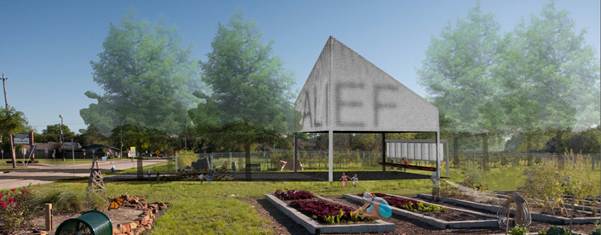Summer time is work time for the University of Houston’s Graduate Design/Build Studio (UH GDBS). Each year, the studio’s students brave Houston’s heat to help enhance the city’s landscape.
By designing and constructing useful community amenities, UH GDBS has helped local schools, parks, and nonprofit organizations. This year was no different as the studio produced a solar-powered outdoor classroom/butterfly pavilion for Alief’s community garden.
Their hard work received a “green” thumbs up from the community and soon will be presented with the Mayor’s Proud Partner Award by Keep Houston Beautiful. The award honors projects that enhance and beautify the city. UH architecture professor Patrick Peters and GDBS students will accept the award during the 28th annual Mayor’s Proud Partners Awards luncheon at noon; Oct. 28 at the Houston Hilton Post Oak Hotel.
This steel, shade structure will be welcomed to the community Nov. 10 during a ribbon-cutting event. With solar-powered ceiling fans, the pavilion will provide community members with a place to cool off, as well as a perfect space for educational demonstrations on planting, cooking, vegetables and other topics.
The garden and classroom site are located across the street from Youngblood Intermediate School (at Beechnut Street and Dairy View Lane) on property owned by Alief Independent School District. Once completed, the school can use the classroom for outdoor activities.
Houston’s SPARK School Park Program funded the project with support from Alief Independent School District, Alief International District and Coca-Cola. Other collaborators include architect Christof Spieler and Tolunay-Wong Engineers Inc.
Another UH project received an honorable mention from Keep Houston Beautiful. A solar-powered outdoor demonstration kitchen that was designed by UH architecture and graphic communication students was recognized by this awards program.
For additional details on the project and how it was developed, view the original press release.
GDBS is part of UH’s Gerald D. Hines College of Architecture. Past community projects include a solar shade tree for McReynolds Middle School and an amphitheater classroom for T.H. Rogers School. To learn more about GDBS, visit http://www.uh.edu/gdbs/.
UH’s Gerald D. Hines College of Architecture hosted the symposium “Dynamic Equilibrium at the Water’s Edge: Three Continents Symposium.” Nov. 8 through Nov. 9. This event formally kicked off the college’s participation in the new Tri-Continent Studio. This studio partners the college with architecture schools in Argentina, the Netherlands and Louisiana. Faculty and students from partner institutions will focus on the opportunities and challenges faced by low lying coastal communities in the U.S. and abroad, including challenges brought on by severe weather events, population growth and industrial expansion.
“The idea is to discover the concerns and issues that residents in different areas of the world are facing, and how we as architects can put together global responses to these challenges,” said UH architecture professor Thomas Colbert.
The symposium showcased the expertise of architecture faculty from UH and Tri-Continent Studio institutions – Louisiana State University, Tulane University, University of Buenos Aires and the Technical University, Delft.
The panelists included Dr. Diego A. Sepulveda Carmona, Asst. Professor Urbanism, TU Delft, *Jeffrey Carney, Director, LSU Coastal Sustainability Studio, Associate Professor, School of Architecture, Louisiana State University, *Thomas Colbert, Associate Professor, College of Architecture, University of Houston *Dr. Flavio Janches, Profesor Titular Regular, Arquitectura, Facultad de Arquitectura, Diseno y Urbanismo, Universidad de Buenos Aires *Michael Rotondi, Principal, RoTo Architects, Inc. *Jonathan Tate, Asst. Adjunct Professor, Tulane University *David Waggonner, FAIA, Partner, Waggoner & Ball Architects *Kulapat Yantrsast, Principal, wHY Architecture *Ann Yoachim, Loeb Fellow, Harvard Graduate School of Design *Peter J. Zweig, FAIA, Professor, College of Architecture, University of Houston
UH Prof. Colbert has focused research and previous projects on the Texas Gulf Coast, particularly Galveston and the Houston Ship Channel. He is one of the researchers involved with the Severe Storm Prediction, Education and Evacuation from Disasters Center.
During the next year, Colbert and UH students will work with Tri-Continent Studio partners to generate ideas on how to enhance their respective coastal areas and make them safer. Their work will be documented in exhibitions that will be on view at the College of Architecture.

 Study Architecture
Study Architecture  ProPEL
ProPEL 
